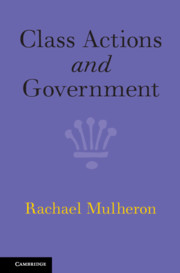Book contents
- Reviews
- Class Actions and Government
- Class Actions and Government
- Copyright page
- Dedication
- Summary of Contents
- Contents
- Figures and Tables
- Preface
- Table of Cases
- Table of Legislation
- Abbreviations
- Notes on Mode of Citation
- 1 Introduction
- Part I Preparing a Path to the Stadium
- Part II As a Participant in the Match
- 6 Government as Representative Claimant
- 7 Government as Class Member
- 8 Government as Class Actions Defendant
- 9 Government as Class Actions Beneficiary
- 10 Conclusion: Levelling the Playing Field
- Bibliography
- Index
6 - Government as Representative Claimant
from Part II - As a Participant in the Match
Published online by Cambridge University Press: 13 March 2020
- Reviews
- Class Actions and Government
- Class Actions and Government
- Copyright page
- Dedication
- Summary of Contents
- Contents
- Figures and Tables
- Preface
- Table of Cases
- Table of Legislation
- Abbreviations
- Notes on Mode of Citation
- 1 Introduction
- Part I Preparing a Path to the Stadium
- Part II As a Participant in the Match
- 6 Government as Representative Claimant
- 7 Government as Class Member
- 8 Government as Class Actions Defendant
- 9 Government as Class Actions Beneficiary
- 10 Conclusion: Levelling the Playing Field
- Bibliography
- Index
Summary
This chapter examines the role of government as representative claimant, representing the class. The government may be a directly affected claimant, or may fulfill the role of an ‘ideological claimant’. This role may fall to a government regulator, most commonly. Difficult legal issues may arise where that representative claimant does not share a cause of action with the class members which it purports to represent, or seeks a remedy which is different from that which the class members are seeking. Much depends upon the level of precision (or lack thereof) with which the class action statute is designed.
- Type
- Chapter
- Information
- Class Actions and Government , pp. 225 - 248Publisher: Cambridge University PressPrint publication year: 2020
- 1
- Cited by

